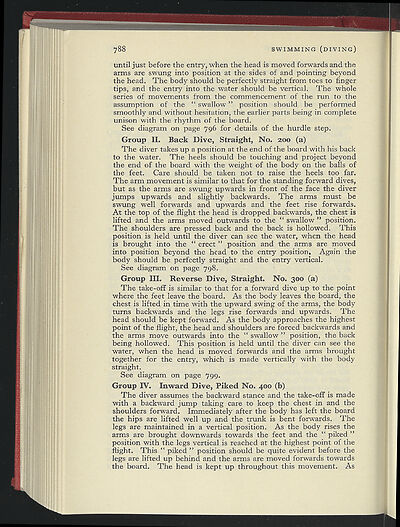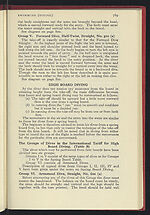1959-60
(862)
Download files
Complete book:
Individual page:
Thumbnail gallery: Grid view | List view

788
SWIMMING (DIVING)
until just before the entry, when the head is moved forwards and the;
arms are swung into position at the sides of and pointing beyond
the head. The body should be perfectly straight from toes to finger
tips, and the entry into the water should be vertical. The whole
series of movements from the commencement of the run to the
assumption of the " swallow " position should be performed
smoothly and without hesitation, the earlier parts being in complete
unison with the rhythm of the board.
See diagram on page 796 for details of the hurdle step.
Group
II.
Back Dive, Straight,
No.
200
(a)
The diver takes up a position at the end of the board with his back
to the water. The heels should be touching and project beyond
the end of the board with the weight of the body on the balls of
the feet. Care should be taken not to raise the heels too far.
The arm movement is similar to that for the standing forward dives,
but as the arms are swung upwards in front of the face the diver
jumps upwards and slightly backwards. The arms must be
swung well forwards and upwards and the feet rise forwards.
At the top of the flight the head is dropped backwards, the chest is
lifted and the arms moved outwards to the " swallow " position.
The shoulders are pressed back and the back is hollowed. This
position is held until the diver can see the water, when the head
is brought into the " erect " position and the arms are moved
into position beyond the head to the entry position. Again the
body should be perfectly straight and the entry vertical.
See diagram on page 798.
Group
III.
Reverse Dive, Straight. No.
300
(a)
The take-off is similar to that for a forward dive up to the point
where the feet leave the board. As the body leaves the board, the
chest is lifted in time with the upward swing of the arms, the body
turns backwards and the legs rise forwards and upwards. The
head should be kept forward. As the body approaches the highest
point of the flight, the head and shoulders are forced backwards and
the arms move outwards into the " swallow " position, the back
being hollowed. This position is held until the diver can see the
water, when the head is moved forwards and the arms brought
together for the entry, which is made vertically with the body
straight.
See diagram on page 799•
Group IV. Inward Dive, Piked No.
400
(b)
The diver assumes the backward stance and the take-off is made
with a backward jump taking care to keep the chest in and the
shoulders forward. Immediately after the body has left the board
the hips are lifted well up and the trunk is bent forwards. The
legs are maintained in a vertical position. As the body rises the
arms are brought downwards towards the feet and the " piked "
position with the legs vertical is reached at the highest point of the
flight. This " piked " position should be quite evident before the
legs are lifted up behind and the arms are moved forwards towards
the board. The head is kept up throughout this movement. As
SWIMMING (DIVING)
until just before the entry, when the head is moved forwards and the;
arms are swung into position at the sides of and pointing beyond
the head. The body should be perfectly straight from toes to finger
tips, and the entry into the water should be vertical. The whole
series of movements from the commencement of the run to the
assumption of the " swallow " position should be performed
smoothly and without hesitation, the earlier parts being in complete
unison with the rhythm of the board.
See diagram on page 796 for details of the hurdle step.
Group
II.
Back Dive, Straight,
No.
200
(a)
The diver takes up a position at the end of the board with his back
to the water. The heels should be touching and project beyond
the end of the board with the weight of the body on the balls of
the feet. Care should be taken not to raise the heels too far.
The arm movement is similar to that for the standing forward dives,
but as the arms are swung upwards in front of the face the diver
jumps upwards and slightly backwards. The arms must be
swung well forwards and upwards and the feet rise forwards.
At the top of the flight the head is dropped backwards, the chest is
lifted and the arms moved outwards to the " swallow " position.
The shoulders are pressed back and the back is hollowed. This
position is held until the diver can see the water, when the head
is brought into the " erect " position and the arms are moved
into position beyond the head to the entry position. Again the
body should be perfectly straight and the entry vertical.
See diagram on page 798.
Group
III.
Reverse Dive, Straight. No.
300
(a)
The take-off is similar to that for a forward dive up to the point
where the feet leave the board. As the body leaves the board, the
chest is lifted in time with the upward swing of the arms, the body
turns backwards and the legs rise forwards and upwards. The
head should be kept forward. As the body approaches the highest
point of the flight, the head and shoulders are forced backwards and
the arms move outwards into the " swallow " position, the back
being hollowed. This position is held until the diver can see the
water, when the head is moved forwards and the arms brought
together for the entry, which is made vertically with the body
straight.
See diagram on page 799•
Group IV. Inward Dive, Piked No.
400
(b)
The diver assumes the backward stance and the take-off is made
with a backward jump taking care to keep the chest in and the
shoulders forward. Immediately after the body has left the board
the hips are lifted well up and the trunk is bent forwards. The
legs are maintained in a vertical position. As the body rises the
arms are brought downwards towards the feet and the " piked "
position with the legs vertical is reached at the highest point of the
flight. This " piked " position should be quite evident before the
legs are lifted up behind and the arms are moved forwards towards
the board. The head is kept up throughout this movement. As
Set display mode to:
![]() Universal Viewer |
Universal Viewer | ![]() Mirador |
Large image | Transcription
Mirador |
Large image | Transcription
| Games and sports in the army > 1959-60 > (862) |
|---|
| Permanent URL | https://digital.nls.uk/248874244 |
|---|
| Description | 'Games and Sports in the Army' was an annual publication produced by the British War Office between the 1930s and 1960s. This included the Second World War. It outlines the rules and regulations for games and sports played by members of the armed forces. It features names and photographs of team members, and examples of contemporary advertising. |
|---|---|
| Shelfmark | GWB.52 |

